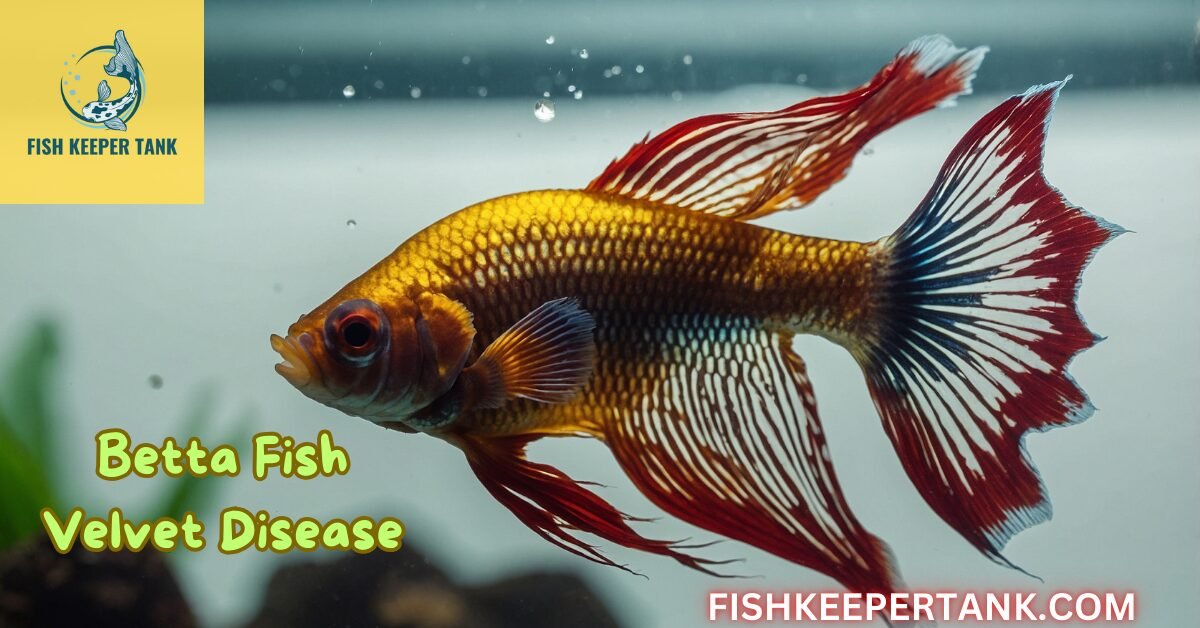Introduction
Betta fish, renowned for their dazzling colors and graceful fins, are a beloved choice among aquarium enthusiasts. However, these stunning creatures are not immune to health challenges, one of the most severe being Velvet Disease. If this parasitic infection isn’t treated fast it can spread extremely quickly and wreak havoc in an aquarium. In this comprehensive guide “Betta Fish Velvet Disease: Velvet Disease In Betta Fish” we will explore the causes, symptoms, treatment, and prevention of Betta Fish Velvet Disease to help you safeguard your aquatic pets.
Understanding Betta Fish Velvet Disease
What Is Velvet Disease?
Velvet Disease, also known as Oodinium or Gold Dust Disease, is caused by a parasitic dinoflagellate from the genus Piscinoodinium. This parasite attacks Betta fish by attaching itself to their skin and gills, feeding on their tissues, and causing severe irritation. It is extremely contagious and untreated infections frequently result in death.
The Velvet Parasite’s Lifecycle
The lifecycle of the Velvet parasite is divided into four key stages:
Trophont Stage: The fish’s tissues are eaten by the parasite which attaches to it.
Tomont Stage: The parasite exits the fish after feeding, encysts on tank surfaces or substrate.
Tomite Stage: When the parasite leaves the cyst, it is free swimming in search of another host.
Reattachment Stage: Because it finds a new fish to infect, it restarts the cycle.
At each stage, you have the chance for intervention, including medication or changed environment.
Symptoms and Identification of Velvet Disease
Here are the most common symptoms of Velvet Disease:
- Loss of Color: Infected Betta fish may exhibit a significant loss of vibrancy in their colors, appearing dull and less lively.
- Rusty or Yellow Film on Skin: The hallmark of Velvet Disease is a golden or rusty film on the fish’s body, resembling a fine dusting of velvet.
- Clamped Fins: Betta fish suffering from Velvet Disease tend to keep their fins close to their body instead of displaying them fully.
- Labored Breathing: If your fish is struggling to breathe heavily or fast at the surface of the tank, the infection may be making the fish breathe this fast.
- Peeling of Skin: Such fish can become sick and appear unhealthy, due to loss of patches of skin.
- Yellow or Orange Spots: At times, with fish infection, you might notice distinct yellow or orange spots on the fish.
- Scratching Against Objects: If a Betta has an infection, it will probably start scratching at decorations in your aquarium to try to get rid of irritation in its skin.
- Lethargy: If your fish appears sluggish and inactive, this could be another symptom of Velvet Disease.
- Loss of Appetite and Weight: A decrease in appetite leads to weight loss and increasing weakness; infection of fish.
Causes of Velvet Disease
Understanding the root causes of Velvet Disease can help prevent outbreaks:
- Contaminated Water: Parasites thrive in poor water quality where the water ammonia, nitrite or nitrate levels are high. Water needs to be tested regularly and cleaned.
- Contaminated Food: Feeding your Betta fish contaminated or low-quality food can introduce pathogens that lead to illness. How Long Can Betta Fish Go Without Food?
- Contaminated Decorations: Substrate, rocks, and ornaments in the tank can harbor parasites and dangerous microorganisms if not properly cleaned.
- Infected Tankmates: Introducing new fish without proper quarantine can bring Velvet Disease into your aquarium. New additions should always be separated in isolation for 2–4 weeks
Betta Fish Habitat
In the Wild
Betta fish originate from Southeast Asia’s shallow waters, such as rice paddies and slow-moving streams. The vegetation in these areas is abundant, creating a fantastic hiding and low stress area.
In Captivity
The important thing is replicating their natural habitat. Betta fish require a clean tank with stable water parameters, proper filtration, and decorations for enrichment. Poorly maintained tanks can diminish the immunity, to avoid diseases, and it may lead to a stressful life.
Treatment for Velvet Disease
- Quarantining the Fish: Infected fish should be isolated to a separate tank to prevent the parasite spread.
- Changing Water Parameters: Perform regular water change and maintain optimal parameters (pH: 6.Ammonia: 0 ppm, nitrate: <20 ppm, 5–7.5). Recovery is supported by clean water.
- Antiparasitic Medications: The parasite can be killed by copper based treatments, such as copper sulfate. Be careful to follow dosage instructions.
- Aquarium Salt: To relieve stress and help gill function, add 1 teaspoon per gallon.
- Increased Water Temperature: Gradually increase the temperature to 82 to 86 F (28 to 30 C) and the parasite’s lifecycle will speed up; it will be less resistant to treatment.
- Dark Tank Environment: The velvet parasites need light for photosynthesis. Their growth is disrupted by keeping the tank dark.
- Consulting a Veterinarian: If symptoms continue even after treatment, seek professional advice.
Prevention of Velvet Disease
- Regular Tank Maintenance.
- Water changes (20–30%) should be performed weekly.
- Clean substrate and decorations as often as possible.
- Test water parameters often to keep things stable.
- New fish should be quarantined 2–4 weeks before it is introduced to the main tank.
- Optimal Tank Conditions maintaining
- You need to use a reliable filtration system. Do Betta Fish Need A Filter To Survive?
- Keep an eye on, and regulate water temp and pH to be stable.
- Overcrowding should be avoided in order to reduce stress.
Conducive Environments for Velvet Disease
Certain conditions make tanks more prone to Velvet outbreaks:
- Dirty Tanks: Parasite growth thrives on excessive organic waste.
- Overcrowding: It increases stress and disease transmission.
- Fluctuating Temperatures: Weakens immune systems.
- Bright Lighting: It promotes parasite reproduction. Do Betta Fish Need Sunlight?
Conclusion
Velvet Disease is a serious but preventable condition that poses a significant threat to Betta fish. This comprehensive guide “Betta Fish Velvet Disease: Understanding, Treating, and Preventing This Common Ailment” helped you to maintain a healthy aquarium by understanding the causes, symptoms and treatment options for Ichthyophthirius. Regular tank maintenance, good quarantine practices, and stable water conditions are the only real prevention from outbreaks. Stay vigilant, and your Betta fish can thrive in a safe and vibrant environment.
Remember: “A Healthy Betta Is A Happy Betta.”
Frequently Asked Questions
What is the best way to treat Velvet Disease?
Quarantine the infected fish, treat with antiparasitic medications, change the water and see what works best.
Can Velvet Disease be prevented?
Although, yes, if you keep the water clean, provide the proper diet, and quarantine new fish it can prevent an outbreak.
Is Velvet Disease contagious?
Yes, Velvet Disease is highly contagious and can spread to healthy fish in the same tank.
How long does Velvet Disease take to kill a fish?
If left untreated, Velvet Disease can kill a fish within 2–7 days of showing symptoms. If you see any of your Betta’s symptoms, early detection, and treatment is the key to saving him.
Can Velvet Disease affect other types of fish?
Yes, Velvet Disease is not exclusive to Betta fish. A wide variety of freshwater and saltwater fish species can be infected.
Is Velvet Disease contagious to humans?
No, Velvet Disease is not contagious to humans. Handling infected fish or cleaning their tanks, however, requires extremely proper hygiene.
How can I disinfect an aquarium after Velvet Disease?
To disinfect an aquarium, put all fish and plants somewhere else and clean decorations and the tank with a bleach solution (1 part bleach to 9 parts water). Rinse thoroughly, allow everything to air dry and reintroduce fish.
How often should I check for Velvet Disease symptoms?
Regularly observe your Betta fish for any behavioral or physical changes. Performing daily checks ensures early detection of Velvet Disease or other health issues.
People Also Read:

